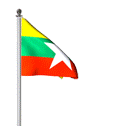The Republic of the Union of Myanmar
Location
Located in the Southeast Asia region, Myanmar lies between north latitude 9 degrees 32 minutes and 28 degrees 31 minutes and between longitudes 92 degrees 10 minutes East and 101 degrees 11 minutes East. Its neighbours are China to the north and northeast; Laos to the east; Thailand to the south-east; and India and Bangladesh to the west and bordering the Andaman Sea and the Bay of Bengal. The City of Yangon lies at 96 degrees 13 minutes east longitude and 16 degrees 45 minutes north latitude. The east longitude 97 degrees 30 minutes is designated for Myanmar standard time and the MST is 6 hours and 30 minutes earlier than GMT.
Area
With a total land area of 261228 sq miles (677,000 sq km), the country stretches over 1275 miles (2051 km) from north to south and 582 miles (936 km) east to west. The country’s border line stretches about 5200 miles and sharing 3808 miles with neighbouring countries — 1357 miles with China, 1314 miles with Thailand, 857 miles with India, 152 miles with Bangladesh and 128 miles with Laos. It has a 1385 miles long coastline from Nat River to Kawthoung.
Topography
Roughly, the topographic condition of Myanmar can be divided into three parts— western ranges, central plains and eastern hilly regions. Myanmar is adjacent to Himalayan ranges which lie in the western part of the country. The Khakaborazi Mountain with the height of 19296 feet is a part of the western ranges and the Saramayti Mountain is 12553 feet high. The western ranges divide India and Myanmar as a wall. In the central plains, the Ayeyawady delta region is the largest one and it is divided into three parts— first part of the region is from the upper reaches to Mandalay, the second part from Mandalay to Pyay and the third part from Pyay to its end. Sittaung basin and Chindwin basin are included in the central plain. In the central plain, there also exist Zeebyu mountain range, Minwon mountain range, Hmankin mountain range and Gangaw mountain range. Bago Mountain range lies from north to south in the region. Shan Plateau is called the eastern mountain range which has an average height of 3000 to 4000 feet. Although it is called a plateau, there exists mountains with high slopes. Across the plateau Thanlwin river flows from north to south— Shan Plateau to Taninthayi coastal region. Zawgyi, Myitnge and Panlaung rivers originate in the Shan Plateau and enter the River Ayeyawady.
Population
The Republic of the Union of Myanmar is home to over 100 national races and the main stocks are Kachin, Kayah, Kayin, Chin, Bamar, Mon, Rakhine and Shan. According to the data in 1998-99, the population of the country has reached 47.25 million and the increase rate is 1.84 per cent. The number of man reaches 28.1 million and woman 28.4 million. According to the statistics of 11-7-2007, the population of Myanmar is 56.5 million.
Climate
Generally, Myanmar has three seasons. The summer is from March to May, the rainy season from middle of May to end of October, and the cold season from November to end of February. Myanmar enjoys a tropical monsoon climate. However, climatic conditions differ widely from place to place due to widely diverse topographical conditions. For instance, Central Myanmar has an annual rainfall of less than 40 inches while the Rakhine Coast gets about 200 inches. The temperature of Central Myanmar is a bout 110 degrees Fahrenheit (43.3 degrees Centigrade ) in the months of March and April. During the period, the temperature of the northern part of Myanmar reaches 97 degrees Fahrenheit (36.1 degrees Centigrade) and in Shan Plateau it is about 85 to 95 degree Fahrenheit (29.4 to 35 degrees Centigrade). Temperature of towns vary according to their location and elevation. In some years past, severe storms occurred causing damages in coastal regions. In order to bring about the favourable climatic conditions, the State has given priority to Central Myanmar Greening Project.
Religion
Myanmar enjoys religious tolerance and since the ancient times, there has been full freedom of worship for followers of different religions. So, different religions can be practised in Myanmar. The religious edifices and religious orders have been in existence and religious festivals can be held on a grand scale. The majority of the population embraces Buddhism with 89.3 per cent but other religions can be practised freely. In the country, Christian occupies 5.06 per cent of the population, Islam 3.8 per cent, Hindu 0.5 per cent and Animist 0.2 percent.


